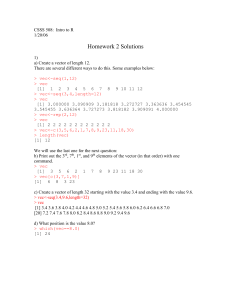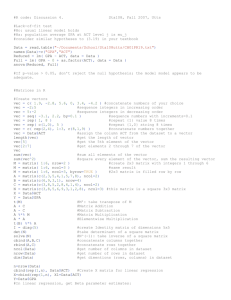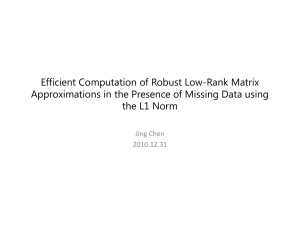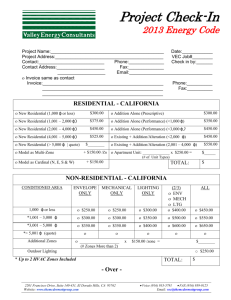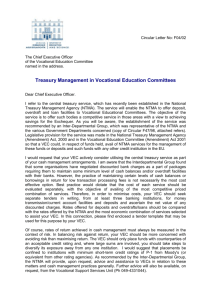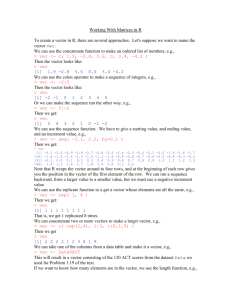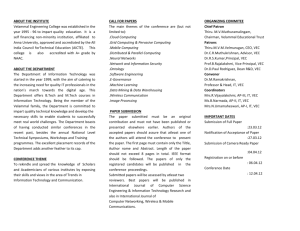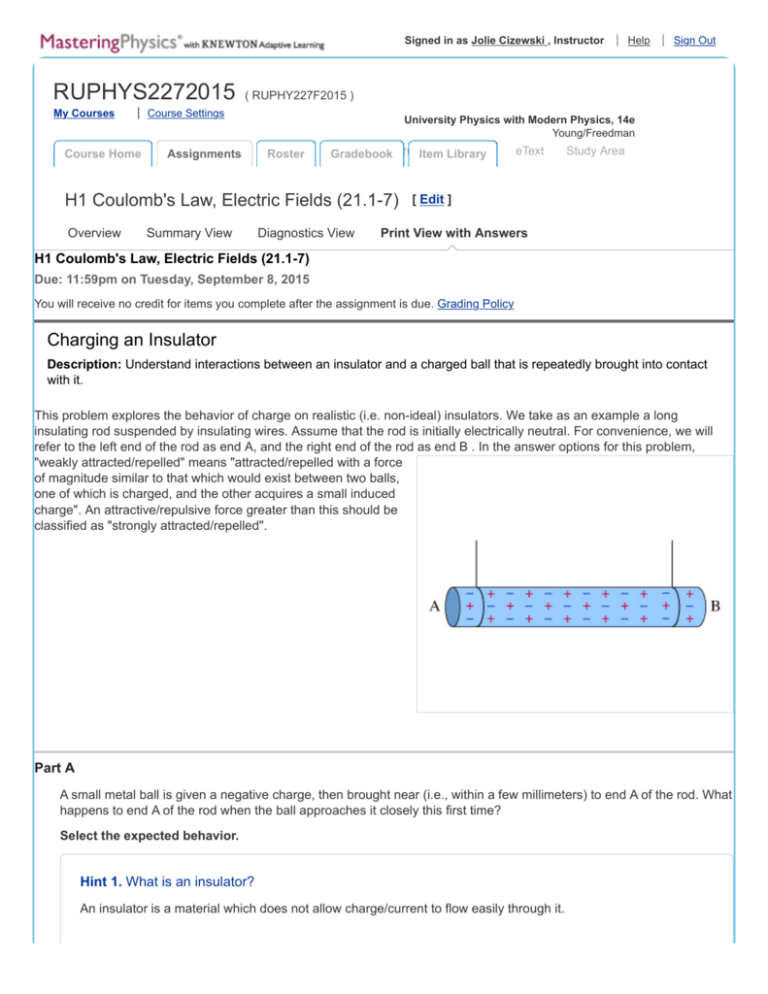
Signed in as Jolie Cizewski , Instructor
RUPHYS2272015
My Courses
Course Home
Sign Out
( RUPHY227F2015 )
Course Settings
Assignments
University Physics with Modern Physics, 14e
Young/Freedman
Roster
Instructor
Resources
Gradebook
Item
Library
H1 Coulomb's Law, Electric Fields (21.1-7)
Overview
Help
Summary View
Diagnostics View
eText
Study Area
[ Edit ]
Print View with Answers
H1 Coulomb's Law, Electric Fields (21.1-7)
Due: 11:59pm on Tuesday, September 8, 2015
You will receive no credit for items you complete after the assignment is due. Grading Policy
Charging an Insulator
Description: Understand interactions between an insulator and a charged ball that is repeatedly brought into contact
with it.
This problem explores the behavior of charge on realistic (i.e. non-ideal) insulators. We take as an example a long
insulating rod suspended by insulating wires. Assume that the rod is initially electrically neutral. For convenience, we will
refer to the left end of the rod as end A, and the right end of the rod as end B . In the answer options for this problem,
"weakly attracted/repelled" means "attracted/repelled with a force
of magnitude similar to that which would exist between two balls,
one of which is charged, and the other acquires a small induced
charge". An attractive/repulsive force greater than this should be
classified as "strongly attracted/repelled".
Part A
A small metal ball is given a negative charge, then brought near (i.e., within a few millimeters) to end A of the rod. What
happens to end A of the rod when the ball approaches it closely this first time?
Select the expected behavior.
Hint 1. What is an insulator?
An insulator is a material which does not allow charge/current to flow easily through it.
Hint 2. Charge at end A
Keeping in mind that like charges repel each other, and opposite charges attract each other, what sort of charge
is induced at end A of the (non-ideal) insulating rod?
ANSWER:
A small positive charge
A small negative charge
ANSWER:
strongly repelled
strongly attracted
weakly attracted
weakly repelled
neither attracted nor repelled
Currently, you can think of this in the following way: When the sphere is brought near the rod, a positive charge is
induced at end A (and correspondingly, end B acquires a negative induced charge). This means that some charge
must have flowed from A to B. Since charge flow is inhibited in an insulator, the induced charges are typically
small. Later you will learn how to model insulators more accurately and formulate a slightly more accurate
argument.
Now consider what happens when the small metal ball is repeatedly given a negative charge and then brought into contact
with end A of the rod
Part B
After several contacts with the charged ball, how is the charge on the rod arranged?
Select the best description.
Hint 1. What is an insulator?
An insulator is a material which does not allow charge/current to flow easily through it.
ANSWER:
positive charge on end B and negative charge on end A
negative charge spread evenly on both ends
negative charge on end A with end B remaining almost neutral
positive charge on end A with end B remaining almost neutral
none of the above
When the sphere is touched to end A, some of its negative charge will be deposited there. However, since charge
cannot flow easily through an insulator, most of this charge will just sit at end A and will not distribute itself over the
rod, as it would if the rod was a conductor.
Part C
How does end A of the rod react when the ball approaches it after it has already made several contacts with the rod,
such that a fairly large charge has been deposited at end A?
Select the expected behavior.
ANSWER:
strongly repelled
strongly attracted
weakly attracted
weakly repelled
neither attracted nor repelled
More on insulators
You may have learnt that any material is made of atoms, which in turn consist of a nucleus and electrons. In the
atoms of some materials, some of the electrons are "bound" to the nucleus very weakly, which leaves them free to
move around the volume of the material. Such electrons are called "free" electrons, and such materials are called
conductors, because the charge (i.e. electrons) can move around easily. In insulators, all the electrons in the atom
are bound quite tightly to the nucleus, i.e. there are no free electrons available to move through the insulator.
Coulomb's Law Tutorial
Description: Use Coulomb's law to compute the (vector) force between two, and subsequently multiple, electric
charges (both positive and negative). One charge acts at an angle of pi/4 radians relative to the given coordinate axes,
and thus trigonometry is required to solve the problem.
Learning Goal:
To understand how to calculate forces between charged particles, particularly the dependence on the sign of the charges
and the distance between them.
Coulomb's law describes the force that two charged particles exert on each other (by Newton's third law, those two forces
must be equal and opposite). The force F21 exerted by particle 2 (with charge q 2 ) on particle 1 (with charge q1 ) is
proportional to the charge of each particle and inversely proportional to the square of the distance r between them:
⃗ =
F 21
k q2 q1
r2
r^21 ,
1
and r^21 is the unit vector pointing from particle 2 to particle 1. The force vector will be parallel or
4πϵ 0
^21 , parallel if the product q1 q2 > 0 and antiparallel if q1 q2 < 0; the force is attractive if
antiparallel to the direction of r
the charges are of opposite sign and repulsive if the charges are of the same sign.
where k
Part A
=
Consider two positively charged particles, one of charge q0
(particle 0) fixed at the origin, and another of charge q 1
(particle 1) fixed on the y-axis at (0, d 1 , 0). What is the net
⃗
force F on particle 0 due to particle 1?
Express your answer (a vector) using any or all of k , q 0 ,
q 1 , d 1 , ^i , ^j , and k^ .
ANSWER:
F⃗ =
Also accepted:
Part B
Now add a third, negatively charged, particle, whose charge
is −q2 (particle 2). Particle 2 fixed on the y-axis at position
(0, d 2 , 0). What is the new net force
on particle 0, from particle 1 and particle 2?
Express your answer (a vector) using any or all of k , q 0 ,
q 1 , q 2 , d 1 , d 2 , ^i , ^j , and k^ .
ANSWER:
F⃗ =
Also accepted:
Part C
Particle 0 experiences a repulsion from particle 1 and an attraction toward particle 2. For certain values of d 1 and d 2 ,
the repulsion and attraction should balance each other, resulting in no net force. For what ratio d 1 /d 2 is there no net
force on particle 0?
Express your answer in terms of any or all of the following variables: k , q0 , q 1 , q2 .
ANSWER:
d 1 /d 2 =
Part D
Now add a fourth charged particle, particle 3, with positive
charge q3 , fixed in the yz-plane at (0, d 2 , d 2 ). What is the
⃗
net force F on particle 0 due solely to this charge?
i , ^j ,
Express your answer (a vector) using k , q 0 , q3 , d 2 , ^
^ . Include only the force caused by particle 3.
and k
Hint 1. Find the magnitude of force from particle 3
What is the magnitude of the force on particle 0 from particle 3, fixed at (0,
d 2 , d2 )?
Express your answer using k , q0 , q 3 , d 2 .
Hint 1. Distance to particle 3
Use the Pythagorean theorem to find the straight line distance between the origin and (0,
ANSWER:
d 2 , d 2 ).
F3 =
Also accepted:
Hint 2. Vector components
The force vector points from q3 to q 0 . Because q3 is symmetrically located between the y-axis and the z-axis,
^30 , the unit vector pointing from particle 3 to particle 0, and the y-axis is π/4 radians. You
the angle between r
have already calculated the magnitude of the vector above. Now break up the force vector into its y and z
components.
ANSWER:
F⃗ =
Also accepted:
Mystery Charge
Description: Calculate an unknown charge from known charges and forces derived from Coulomb's law
Consider the following configuration of fixed, uniformly charged spheres (see the figure):
a blue sphere fixed at the origin with positive charge q ,
a red sphere fixed at the point (d 1 , 0) with unknown
charge qred , and
a yellow sphere fixed at the point
(d 2 cos(θ), −d2 sin(θ)) with unknown charge qyellow .
The net electric force on the blue sphere has a magnitude F and
is directed in the − y direction.
Part A
What is the sign of the charge on the yellow sphere?
ANSWER:
positive
negative
Part B
What is the sign of the charge on the red sphere?
ANSWER:
positive
negative
Part C
Suppose that the magnitude of the charge on the yellow sphere is determined to be 2q . Calculate the charge qred on
the red sphere.
Express your answer in terms of q , d 1 , d 2 , and θ.
Hint 1. How to approach the problem
From the problem statement, you know that the x component of the net force acting on the blue sphere is zero.
The red sphere and the yellow sphere each exert a force on the blue sphere. You know the charge of the yellow
sphere. This allows you to calculate the x component of the force that the yellow sphere exerts on the blue
sphere. You need to find the appropriate charge q red for the red sphere such that the x components of the two
forces sum to zero.
Hint 2. Find the x component of the force due to the yellow sphere
Find Fx yellow , the x component of the force that the yellow sphere exerts on the blue sphere.
Express your answer in terms of q , d 2 , and θ . You may use k for 1/4πϵ 0 , where ϵ 0 represents the
permittivity of free space.
Hint 1. How to approach this part
Use Coulomb's law to find the force due to the yellow charge on the blue charge. Then find the x
component of the force.
ANSWER:
Fx yellow =
Hint 3. Find the force due to the red sphere
F
red
Find Fx red , the x component of the force that the red sphere exerts on the blue sphere.
Express your answer in terms of q , d 1 , and the unknown charge q red . You may use k for 1/4πϵ 0 , where
ϵ 0 represents the permittivity of free space.
ANSWER:
Fx red =
ANSWER:
q red =
Placing Charges Conceptual Question
Description: Simple conceptual question about placing various charges around a central charge such that the free
body diagram given is correct.
Below are free-body diagrams for three electric charges that lie in the same plane. Their relative positions are unknown.
Part A
Along which of the lines (A to H) in the figure should charge
2 be placed so that the free-body diagrams of charge 1 and
charge 2 are consistent?
Hint 1. How to approach the problem
Newton’s 3rd law states that the forces exerted by a pair of objects on each other are always equal in
magnitude and opposite in direction. Identifying the forces that correspond to 3rd-law pairs in the free-body
diagrams will enable you to place the particles in their proper relative position.
Hint 2. Placing charge 2
The two forces acting on charge 2 correspond to the forces exerted on it by charge 1 and charge 3. This means
that one of these forces must pair with a force on charge 1 of equal magnitude and opposite direction and the
other must pair with a force on charge 3 of equal magnitude and opposite direction. Also note that charge 2
should be repelled by charge 1, since both are negative. Therefore, the vector that represents the force of
charge 1 on charge 2 must point away from charge 1. This information is all you need to place charge 2 in its
correct position.
ANSWER:
Part B
Along which of the lines (A to H) in the figure should charge
3 be placed so that the free-body diagrams of charge 1,
charge 2, and charge 3 are consistent?
ANSWER:
D
Part C
Along which of the lines (A to H) in the figure should charge
2 be placed so that the free-body diagrams of charge 1 and
charge 2 are consistent?
ANSWER:
H
Part D
Along which lines (A to H) in the figure should charge 3 be
placed so that the free-body diagrams of charge 1, charge 2,
and charge 3 are consistent?
ANSWER:
F
Exercise 21.33
Description: A point charge is at the origin. With this point charge as the source point, what is the unit vector r_unit in
the direction of (a) the field point at x = 0 , y = -1.35m; (b) the field point at x = 12.0cm, y = 12.0cm; (c) the field point at
x = -...
A point charge is at the origin. With this point charge as the source point, what is the unit vector r^ in the direction of (a) the
field point at x = 0 , y = -1.35m ; (b) the field point at x = 12.0cm, y = 12.0cm ; (c) the field point at x = - 1.10m , y = 2.60
m ? Express your results in terms of the unit vectors ^i and ^j .
Part A
i and ^j .
Express your answer in terms of the unit vectors ^
ANSWER:
r^ =
Part B
i and ^j .
Express your answer in terms of the unit vectors ^
ANSWER:
r^ =
Part C
i and ^j .
Express your answer in terms of the unit vectors ^
ANSWER:
r^ =
The Electric Field inside a Conductor
Description: Multiple-choice questions about the charge distribution inside a conductor when an external charge is
brought near.
Learning Goal:
To understand how the charges within a conductor respond to an externally applied electric field.
To illustrate the behavior of charge inside conductors, consider a long conducting rod that is suspended by insulating
strings (see the figure). Assume that the rod is initially electrically neutral, and that it remains so for this discussion. The rod
is positioned along the x axis, and an external electric field that points in the positive x direction (to the right) can be applied
to the rod and the surrounding region. The atoms in the rod are composed of positive nuclei (indicated by plus signs) and
negative electrons (indicated by minus signs). Before application of the electric field, these atoms were distributed evenly
throughout the rod.
Part A
What is the force felt by the electrons and the nuclei in the rod when the external field described in the problem
introduction is applied? (Ignore internal fields in the rod for the moment.)
Hint 1. Formula for the force on a charge in an electric field
⃗
⃗
⃗
⃗
The force F on a charge q in an electric field E is given by
F ⃗ = qE⃗ .
ANSWER:
Both electrons and nuclei experience a force to the right.
The nuclei experience a force to the right and the electrons experience a force to the left.
The electrons experience a force to the left but the nuclei experience no force.
The electrons experience no force but the nuclei experience a force to the right.
Part B
What is the motion of the negative electrons and positive atomic nuclei caused by the external field?
Hint 1. How to approch this part
Newton's 2nd Law tells you that an object at rest will move in the direction of the force applied on it.
Hint 2. Masses and charges of nuclei and electrons
A nucleus contains as many protons as the atom does electrons. So if the atom has N electrons, the nucleus
will contain N protons. This means that the force on the nucleus will be N times as much as that on the electron.
This N is of the order of 10-100.
However, the mass of a nucleus is roughly 2N times the mass of a proton, since it contains both protons and
neutrons. Each proton itself weighs about 1836 times as much as an electron! So a typical nucleus really does
weigh a lot more than an electron.
Given this information, how would the distance moved by a nucleus compare with that moved by an electron?
ANSWER:
Both electrons and nuclei move to the right.
The nuclei move to the right and the electrons move to the left through equal distances.
The electrons move to the left and the nuclei are almost stationary.
The electrons are almost stationary and the nuclei move to the right.
The nuclei of the atoms of a conducting solid remain almost in their places in the crystal lattice, while the electrons
relatively move a lot. In an insulator, the electrons are constrained to stay with their atoms (or molecules), and at
most, the charge distribution is displaced slightly.
The motion of the electrons due to the external electric field constitutes an electric current. Since the negatively
charged electrons are moving to the left, the current, which is defined as the "flow" of positive charge, moves to
the right.
Part C
Imagine that the rightward current flows in the rod for a short time. As a result, what will the net charge on the right and
left ends of the rod become?
Hint 1. How to approach this part
Remember that the rod as a whole must remain electrically neutral even if the charges are redistributed. This is
because applying an electric field does not change the charge on the rod, only redistributes it.
ANSWER:
left end negative and right end positive
left end negative and right end negative
left end negative and right end nearly neutral
left end nearly neutral and right end positive
both ends nearly neutral
Given that the positively charged nuclei do not move, why does the right end of the rod become positively
charged? The reason is that some electrons have moved to the left end, leaving an excess of stationary nuclei at
the right end.
Part D
The charge imbalance that results from this movement of charge will generate an additional electric field in the region
within the rod. In what direction will this field point?
Hint 1. Direction of the electric field
The electric field point away from positive charges and towards negative ones.
ANSWER:
It will point to the right and enhance the initial applied field.
It will point to the left and oppose the initial applied field.
An electric field that exists in an isolated conductor will cause a current flow. This flow sets up an electric field that
opposes the original electric field, halting the motion of the charges on a nanosecond time scale for meter-sized
conductors. For this reason, an isolated conductor will have no static electric field inside it, and will have a
reduced electric field near it. This conclusion does not apply to a conductor whose ends are connected to an
external circuit. In a circuit, a rod (or wire) can conduct current indefinitely.
Electric Field due to Two Point Charges
Description: Calculate the electric field at a point along the x axis due to two charges that are also situated on the x
axis.
nC
Two point charges are placed on the x axis.The first charge, q 1 = 8.00 nC , is placed a distance 16.0 {\rm m} from the
origin along the positive x axis; the second charge, \texttip{q_{\rm
2}}{q_2} = 6.00 {\rm nC} , is placed a distance 9.00 {\rm m} from
the origin along the negative x axis.
Part A
Find the electric field at the origin, point O.
Give the x and y components of the electric field as an ordered pair. Express your answer in newtons per
coulomb to three significant figures. Keep in mind that an x component that points to the right is positive and
a y component that points upward is positive.
Hint 1. How to approach the problem
Find the contributions to the electric field at the origin separately for \texttip{q_{\rm 1}}{q_1} and \texttip{q_{\rm
2}}{q_2}, then add them together (using vector addition) to find the total electric field at the origin.
Hint 2. Determine the directions of the electric fields
Which of the following describes the directions for the electric fields \texttip{\vec{E}_{\rm O1}}{E_O1_vec} and
\texttip{\vec{E}_{\rm O2}}{E_O2_vec} created by charges \texttip{q_{\rm 1}}{q_1} and \texttip{q_{\rm 2}}{q_2},
respectively?
ANSWER:
Both \texttip{\vec{E}_{\rm O1}}{E_O1_vec} and \texttip{\vec{E}_{\rm O2}}{E_O2_vec} point to the right.
Both \texttip{\vec{E}_{\rm O1}}{E_O1_vec} and \texttip{\vec{E}_{\rm O2}}{E_O2_vec} point to the left.
\texttip{\vec{E}_{\rm O1}}{E_O1_vec} points to the right and \texttip{\vec{E}_{\rm O2}}{E_O2_vec}
points to the left.
\texttip{\vec{E}_{\rm O1}}{E_O1_vec} points to the left and \texttip{\vec{E}_{\rm O2}}{E_O2_vec}
points to the right.
Note that the electric fields of both charges are parallel to the x axis. Therefore, the net electric field has no
y component.
Hint 3. Calculate the electric field due to \texttip{q_{\rm 1}}{q_1}
What is the magnitude of the electric field at the origin due to charge \texttip{q_{\rm 1}}{q_1} only?
Express your answer in newtons per coulomb to three significant figures.
ANSWER:
\texttip{E_{\rm O1}}{E_O1} =
= 0.281
\rm{N/C}
Hint 4. Calculate the electric field due to \texttip{q_{\rm 2}}{q_2}
What is the magnitude of the electric field at the origin due to charge \texttip{q_{\rm 2}}{q_2} only?
Express your answer in newtons per coulomb to three significant figures.
ANSWER:
\texttip{E_{\rm O2}}{E_O2} =
= 0.666
\rm{N/C}
ANSWER:
E_{{\rm O}x}, E_{{\rm O}y} =
,
= 0.385, 0
\rm{N/C}
Part B
Now, assume that charge \texttip{q_{\rm 2}}{q_2} is negative; q_2 = -6 \; \rm {nC}. What is the net electric field at the
origin, point O?
Give the x and y components of the electric field as an
ordered pair. Express your answer in newtons per
coulomb to three significant figures. Keep in mind that
an x component that points to the right is positive and a
y component that points upward is positive.
Hint 1. How to approach the problem
Find the contributions to the electric field at the origin separately for \texttip{q_{\rm 1}}{q_1} and \texttip{q_{\rm
2}}{q_2}, then add them together (using vector addition) to find the total electric field at the origin.
Hint 2. Determine the directions of the electric fields
Which of the following describes the directions for the electric fields \texttip{\vec{E}_{\rm O1}}{E_O1_vec} and
\texttip{\vec{E}_{\rm O2}}{E_O2_vec} created by charges \texttip{q_{\rm 1}}{q_1} and \texttip{q_{\rm 2}}{q_2},
respectively?
ANSWER:
Both \texttip{\vec{E}_{\rm O1}}{E_O1_vec} and \texttip{\vec{E}_{\rm O2}}{E_O2_vec} point to the right.
Both \texttip{\vec{E}_{\rm O1}}{E_O1_vec} and \texttip{\vec{E}_{\rm O2}}{E_O2_vec} point to the left.
\texttip{\vec{E}_{\rm O1}}{E_O1_vec} points to the right whereas \texttip{\vec{E}_{\rm O2}}{E_O2_vec}
points to the left.
\texttip{\vec{E}_{\rm O1}}{E_O1_vec} points to the left whereas \texttip{\vec{E}_{\rm O2}}{E_O2_vec}
points to the right.
ANSWER:
E_{{\rm O}x}, E_{{\rm O}y} =
,
= -0.947, 0
\rm{N/C}
Visualizing Electric Fields
Description: Select the correct drawing of electric field lines for several situations and answer questions about why
other choices are incorrect. Then, these ideas are demonstrated with an applet.
Learning Goal:
To understand the nature of electric fields and how to draw field lines.
Electric field lines are a tool used to visualize electric fields. A field line is drawn beginning at a positive charge and ending
at a negative charge. Field lines may also appear from the edge of a picture or disappear at the edge of the picture. Such
lines are said to begin or end at infinity. The field lines are directed so that the electric field at any point is tangent to the
field line at that point.
shows two different ways to visualize an electric field. On the left,
vectors are drawn at various points to show the direction and
magnitude of the electric field. On the right, electric field lines
depict the same situation. Notice that, as stated above, the
electric field lines are drawn such that their tangents point in the
same direction as the electric field vectors on the left. Because of
the nature of electric fields, field lines never cross. Also, the
vectors shrink as you move away from the charge, and the
electric field lines spread out as you move away from the charge.
The spacing between electric field lines indicates the strength of
the electric field, just as the length of vectors indicates the
strength of the electric field. The greater the spacing between
field lines, the weaker the electric field. Although the advantage
of field lines over field vectors may not be apparent in the case of
a single charge, electric field lines present a much less cluttered
and more intuitive picture of more complicated charge
arrangements.
Part A Which of the following panels (labelled A, B, C, and D) in
correctly depicts the field lines from an infinite uniformly
negatively charged sheet? Note that the sheet is being
viewed edge-on in all pictures.
Hint 1. Description of the field
Recall that the field around an infinite charged sheet is always perpendicular to the sheet and that the field
strength does not change, regardless of distance from the sheet.
ANSWER:
A
B
C
D
Part B
In , what is wrong with panel B? (Pick only those statements
that apply to panel B.)
Check all that apply.
ANSWER:
Field lines cannot cross each other.
The field lines should be parallel because of the sheet's symmetry.
The field lines should spread apart as they leave the sheet to indicate the weakening of the field with
distance.
The field lines should always end on negative charges or at infinity.
Part C Which of the following panels (labelled A, B, C, and D) in
shows the correct electric field lines for an electric dipole?
ANSWER:
A
B
C
D
This applet shows two charges. You can alter the charge on each independently or alter the distance between
them. You should try to get a feeling for how altering the charges or the distance affects the field lines.
Part D
In , what is wrong with panel D? (Pick only those statements that apply to panel D.)
Check all that apply.
ANSWER:
Field lines cannot cross each other.
The field lines should turn sharply as you move from one charge to the other.
The field lines should be smooth curves.
The field lines should always end on negative charges or at infinity.
Even in relatively simple setups as in the figure shown,
electric field lines are quite helpful for understanding the field qualitatively (understanding the general direction in
which a certain charge will move from a specific position, identifying locations where the field is roughly zero or
where the field points a specific direction, etc.). A good figure with electric field lines can help you to organize your
thoughts as well as check your calculations to see whether they make sense.
Part E
In , the electric field lines are shown for a system of two point charges, \texttip{Q_{\rm A}}{Q_A} and \texttip{Q_{\rm B}}
{Q_B}. Which of the following could represent the magnitudes and signs of \texttip{Q_{\rm A}}{Q_A} and \texttip{Q_{\rm
B}}{Q_B}?
In the following, take \texttip{q}{q} to be a positive quantity.
ANSWER:
Q_{\rm A} = +q, Q_{\rm B} = -q
Q_{\rm A} = +7q, Q_{\rm B} = -3q
Q_{\rm A} = +3q, Q_{\rm B} = -7q
Q_{\rm A} = -3q, Q_{\rm B} = +7q
Q_{\rm A} = -7q, Q_{\rm B} = +3q
Very far from the two charges, the system looks like a single charge with value Q_{\rm A} + Q_{\rm B} = +4q. At
large enough distances, the field lines will be indistinguishable from the field lines due to a single point charge
+4q.
Torque on a Dipole in a Uniform Field
Description: Calculate the torque on and the potential energy of a dipole (two opposite charges) in a uniform electric
field.
Consider an electric dipole whose dipole moment (a vector
pointing from the negitive charge to the positive charge) is
oriented at angle \texttip{\theta }{theta} with respect to the y axis.
There is an external electric field of magnitude \texttip{E}{E}
(independent of the field produced by the dipole) pointing in the
positive y direction. The positive and negative ends of the dipole
have charges + \texttip{q}{q} and - \texttip{q}{q}, respectively, and
the two charges are a distance \texttip{d}{d} apart. The dipole
has a moment of inertia \texttip{I}{I} about its center of mass. It
will help you to imagine that the dipole is free to rotate about a
pivot through its center.
Part A
What is the net force \texttip{\vec{F}_{\rm net}}{F_net_vec} that the dipole experiences due to the electric field?
Express \texttip{\vec{F}_{\rm net}}{F_net_vec} in terms of the given variables and the unit vectors
\texttip{\hat{i}}{i_unit}, \texttip{\hat{j}}{j_unit}.
Hint 1. What is the force on the positive charge?
What is the force \texttip{\vec{F}_{\rm pos}}{F_pos_vec} that the charge + \texttip{q}{q} experiences due to the
electric field in the y direction?
Express \texttip{\vec{F}_{\rm pos}}{F_pos_vec} in terms of the given variables and the unit vectors
\texttip{\hat{i}}{i_unit}, \texttip{\hat{j}}{j_unit}.
ANSWER:
\texttip{\vec{F}_{\rm pos}}{F_pos_vec} =
ANSWER:
\texttip{\vec{F}_{\rm net}}{F_net_vec} =
Also accepted:
Part B
What is \texttip{\tau _{\rm cm}\left(\theta \right)}{tau_cm(theta)}, the magnitude of the torque that the electric field exerts
about the center of mass of the dipole?
Express the magnitude of the total torque in terms of the given quantities.
Hint 1. Find the torque on the positive charge
What is the magnitude of the torque \texttip{\tau _{\rm pos}}{tau_pos} about the center of mass of the dipole due
to the force that the electric field exerts on the positive charge? Recall that the torque vector is given by
\vec{\tau}=\vec{R}\times\vec{F}, where \texttip{\vec{R}}{R_vec} is the position vector from the center of the
dipole to the applied force \texttip{\vec{F}}{F_vec}.
Express the magnitude of the torque in terms of the given quantities.
Hint 1. Find the force on the positive charge
What is the force \texttip{\vec{F}_{\rm pos}}{F_pos_vec} that the charge + \texttip{q}{q} experiences due
to the electric field in the y direction?
Express your answer in terms of the given variables and the unit vectors \texttip{\hat{i}}{i_unit},
\texttip{\hat{j}}{j_unit}.
ANSWER:
\texttip{\vec{F}_{\rm pos}}{F_pos_vec} =
Hint 2. What is the moment arm?
A simple way to compute the magnitude of the torque about a pivot point is to multiply the magnitude of
the force by the moment arm, which is the distance from the line of force to the chosen pivot point (and
to apply a negative sign if the torque is clockwise). What is the moment arm \texttip{R_{\rm pos}}{R_pos}
for the force on the positive charge in this problem?
Express your answer in terms of the given distances and angles.
ANSWER:
\texttip{R_{\rm pos}}{R_pos} =
ANSWER:
\texttip{\tau _{\rm pos}}{tau_pos} =
Hint 2. Now consider the negative charge
Now find the magnitude torque on the negative charge. To find the magnitude of the net torque on the center of
mass of the dipole, you need to consider whether the torques on the two charges act in the same or opposite
directions. If both torques tend to rotate the dipole in the same direction, sum them to find the magnitude of the
net torque, otherwise, subtract the smaller from the larger.
ANSWER:
\texttip{\tau _{\rm cm}\left(\theta \right)}{tau_cm(theta)} =
Part C
Using the above result, find the potential energy \texttip{U\left(\theta \right)}{U(theta)} associated with the dipole's
orientation in the field as a function of the angle \texttip{\theta }{theta} shown in the figure. Take the zero of the potential
to occur when the dipole is at angle \pi/2; that is, U(\pi/2) = 0.
Express \texttip{U\left(\theta \right)}{U(theta)} in terms of the given quantities.
Hint 1. The definition of potential energy
The potential energy associated with a conservative force \texttip{F\left(x\right)}{F(x)} is given by
\large{U(x) = -\int_{x_0}^x F(x')\,dx'}.
This definition ensures that F(x) = -\nabla U(x). The potential energy function associated with a torque is found
analogously, essentially by multiplying both sides of this equation by a distance (so force is converted to
torque), and then integrating with respect to angle rather than distance (since the distance has already been
absorbed into the functions). Thus if the torque is given by \tau(\theta), the associated potential energy is
\large{U(\theta) = -\int_{\theta_0}^{\theta} \tau(\theta')\, d\theta'}.
Note that the lower bound of this integral is arbitrary. You will have to determine an appropriate constant of
integration.
Hint 2. How to choose the constant of integration
When you integrate to find U(\theta), choose the constant of integration to satisfy the condition U(\pi/2)=0.
ANSWER:
\texttip{U\left(\theta \right)}{U(theta)} =
Part D
In terms of the dipole moment \texttip{\vec{P}}{P_vec}, which of the following is an expression for the torque on a
dipole in the field \texttip{\vec{E}}{E_vec}?
Hint 1. How to approach this part
The general relation between the torque, dipole moment and electric field may be hard to derive. However, you
can easily compare the magnitude and/or direction of the torque derived for the particular case considered
above with the magnitudes and/or directions of the expressions given below for the same physical situation.
Hint 2. Formula for \vec{a} \times \vec{b}
Let \vec{c} = \vec{a} \times \vec{b}. Then
|\vec{c}| = |\vec{a}||\vec{b}| \sin\theta,
where \texttip{\theta }{theta} is the smaller angle between \texttip{\vec{a}}{a_vec} and \texttip{\vec{b}}{b_vec}.
The direction of \texttip{\vec{c}}{c_vec} is given by the right-hand rule: stretch out the thumb of your right hand
and curl the remaining fingers from \texttip{\vec{a}}{a_vec} to \texttip{\vec{b}}{b_vec}. Then your outstretched
thumb gives the direction of \texttip{\vec{c}}{c_vec}.
Hint 3. Formula for \vec{a} \cdot \vec{b}
The formula for \vec{a} \cdot \vec{b} is
\vec{a} \cdot \vec{b} = |\vec{a}||\vec{b}|\cos\theta,
where \texttip{\theta }{theta} is the smaller angle between \texttip{\vec{a}}{a_vec} and \texttip{\vec{b}}{b_vec}.
Hint 4. More on torques
The direction of the torque vector \texttip{\vec{\tau }}{tau_vec} can be determined from the vector equation
\vec{\tau} = \vec{R} \times \vec{F},
where \texttip{\vec{R}}{R_vec} is a vector that points from the pivot to the point of action of the force
\texttip{\vec{F}}{F_vec}.
ANSWER:
\vec{P} \times \vec{E}
\vec{E} \times \vec{P}
\vec{P} \cdot \vec{E}
-\vec{P} \cdot \vec{E}
Part E
In terms of the dipole moment \texttip{\vec{P}}{P_vec}, which of the following is an expression for the potential energy
of a dipole in the field \texttip{\vec{E}}{E_vec}?
Hint 1. Formula for \vec{a} \times \vec{b}
Let \vec{c} = \vec{a} \times \vec{b}. Then
|\vec{c}| = |\vec{a}||\vec{b}| \sin\theta,
where \texttip{\theta }{theta} is the smaller angle between \texttip{\vec{a}}{a_vec} and \texttip{\vec{b}}{b_vec}.
The direction of \texttip{\vec{c}}{c_vec} is given by the right-hand rule: stretch out the thumb of your right hand
and curl the remaining fingers from \texttip{\vec{a}}{a_vec} to \texttip{\vec{b}}{b_vec}. Then your outstretched
thumb gives the direction of \texttip{\vec{c}}{c_vec}.
Hint 2. Formula for \vec{a} \cdot \vec{b}
The formula for \vec{a} \cdot \vec{b} is
\vec{a} \cdot \vec{b} = |\vec{a}||\vec{b}|\cos\theta,
where \texttip{\theta }{theta} is the smaller angle between \texttip{\vec{a}}{a_vec} and \texttip{\vec{b}}{b_vec}.
ANSWER:
\vec{P} \times \vec{E}
\vec{E} \times \vec{P}
\vec{P} \cdot \vec{E}
-\vec{P} \cdot \vec{E}
The Trajectory of a Charge in an Electric Field
Description: Simple two-dimensional kinematics of a charge moving in a uniform electric field.
An charge with mass \texttip{m}{m} and charge \texttip{q}{q} is emitted from the origin, (x,y)=(0,0). A large, flat screen is
located at x=L. There is a target on the screen at y position \texttip{y_{\rm h}}{y_h}, where y_{\rm h} > 0. In this problem,
you will examine two different ways that the charge might hit the target. Ignore gravity in this problem.
Part A
Assume that the charge is emitted with velocity \texttip{v_{\rm 0}}{v_0} in the positive x direction. Between the origin
and the screen, the charge travels through a constant electric field pointing in the positive y direction. What should the
magnitude \texttip{E}{E} of the electric field be if the charge is to hit the target on the screen?
Express your answer in terms of \texttip{m}{m}, \texttip{q}{q}, \texttip{y_{\rm h}}{y_h}, \texttip{v_{\rm 0}}{v_0},
and \texttip{L}{L}.
Hint 1. How to approach the problem
Once you determine the force on the charge due to the electric field, this becomes a standard two-dimensional
kinematics problem. To solve the problem, first determine the equations of motion in both the x and y directions.
Then use the fact that at some final time \texttip{t_{\rm final}}{t_final} you know that the position of the charge is
(L,y_h) to obtain two equations in terms of the two unknowns \texttip{E}{E} and \texttip{t_{\rm final}}{t_final}.
Eliminate \texttip{t_{\rm final}}{t_final} and solve for \texttip{E}{E}.
Hint 2. Find the equation of motion in the x direction
Find an expression for \texttip{x\left(t\right)}{x(t)}, the charge's x position as a function of time.
Express your answer in terms of \texttip{t}{t} as well as any of the given variables and constants.
Hint 1. Find the force in the x direction
What net force \texttip{F_{\mit x}}{F_x} does the charge experience in the x direction?
Hint 1. Formula for the force on a charge in an electric field
The formula for the force \texttip{\vec{F}}{F_vec} on a charge \texttip{q}{q} in an electric field
\texttip{\vec{E}}{E_vec} is
\vec{F} = q\vec{E}.
ANSWER:
\texttip{F_{\mit x}}{F_x} = 0
Hint 2. A helpful kinematic equation
Recall that kinematic equation that gives the distance \texttip{s}{s} travelled in terms of the initial velocity
\texttip{u}{u}, the acceleration \texttip{a}{a} and elapsed time \texttip{t}{t} is
\large{s = ut + \frac{1}{2}at^2}.
ANSWER:
\texttip{x\left(t\right)}{x(t)} =
Hint 3. Find the equation of motion in the y direction
Find an expression for \texttip{y\left(t\right)}{y(t)}, the charge's y position as a function of time.
Express your answer in terms of \texttip{t}{t} as well as any of the given variables and constants.
Hint 1. Find the force in the y direction
What is the net force acting on the charge in the y direction?
Express your answer in terms of the given variables and constants.
Hint 1. Formula for the force on a charge in an electric field
The formula for the force \texttip{\vec{F}}{F_vec} on a charge \texttip{q}{q} in an electric field
\texttip{\vec{E}}{E_vec} is
\vec{F} = q\vec{E}.
ANSWER:
\texttip{F_{\mit y}}{F_y} =
Notice that the constant field provides a constant force, which yields a constant acceleration. The
kinematics of charge in a constant electric field are not very different from of those of mass in a
constant gravitational field.
Hint 2. A helpful kinematic equation
Recall that kinematic equation that gives the distance \texttip{s}{s} travelled in terms of the initial velocity
\texttip{u}{u}, the acceleration \texttip{a}{a} and elapsed time \texttip{t}{t} is
\large{s = ut + \frac{1}{2}at^2}.
ANSWER:
\texttip{y\left(t\right)}{y(t)} =
Hint 4. Combine Your Results
At some final time \texttip{t_{\rm final}}{t_final}, you have x(t_{\rm final})=L and y(t_{\rm final})=y_h. Starting with
these two equations, eliminate \texttip{t_{\rm final}}{t_final} and solve for \texttip{E}{E}.
Hint 5. Find \texttip{t_{\rm final}}{t_final}
Use the equation for the motion of the charge in the x direction to find \texttip{t_{\rm final}}{t_final}.
Express your answer in terms of the variables \texttip{v_{\rm 0}}{v_0} and \texttip{L}{L}.
ANSWER:
\texttip{t_{\rm final}}{t_final} =
Now substitute t_{\rm final}=L/v_0 into the equation y(t_{\rm final})=y_h and solve for \texttip{E}{E}.
ANSWER:
\texttip{E}{E} =
Part B
Now assume that the charge is emitted with velocity \texttip{v_{\rm 0}}{v_0} in the positive y direction. Between the
origin and the screen, the charge travels through a constant electric field pointing in the positive x direction. What
should the magnitude \texttip{E}{E} of the electric field be if the charge is to hit the target on the screen?
Express your answer in terms of \texttip{m}{m}, \texttip{q}{q}, \texttip{y_{\rm h}}{y_h}, \texttip{v_{\rm 0}}{v_0},
and \texttip{L}{L}.
Hint 1. How to approach the problem
Just as in the previous part, once you determine the force on the charge due to the electric field, this becomes a
standard two-dimensional kinematics problem. To solve the problem, first determine the equations of motion in
both the x and y directions. Then use the fact that at some final time \texttip{t_{\rm final}}{t_final} you know that
the position of the charge is (L,y_h) to obtain two equations in terms of the two unknowns \texttip{E}{E} and
\texttip{t_{\rm final}}{t_final}. Eliminate \texttip{t_{\rm final}}{t_final} and solve for \texttip{E}{E}.
Hint 2. Find the equation of motion in the y direction
Find an expression for \texttip{y\left(t\right)}{y(t)}, the charge's y position as a function of time.
Express your answer in terms of \texttip{t}{t} as well as any of the given variables and constants.
Hint 1. Find the force in the y direction
What net force \texttip{F_{\mit y}}{F_y} does the charge experience in the y direction?
Hint 1. Formula for the force on a charge in an electric field
The formula for the force \texttip{\vec{F}}{F_vec} on a charge \texttip{q}{q} in an electric field
\texttip{\vec{E}}{E_vec} is
\vec{F} = q\vec{E}.
ANSWER:
\texttip{F_{\mit y}}{F_y} = 0
Hint 2. A helpful kinematic equation
Recall that kinematic equation that gives the distance \texttip{s}{s} travelled in terms of the initial velocity
\texttip{u}{u}, the acceleration \texttip{a}{a} and elapsed time \texttip{t}{t} is
\large{s = ut + \frac{1}{2}at^2}.
ANSWER:
\texttip{y\left(t\right)}{y(t)} =
Hint 3. Find the equation of motion in the x direction
Find an expression for \texttip{x\left(t\right)}{x(t)}, the charge's x position as a function of time.
Express your answer in terms of \texttip{t}{t} as well as any of the given variables and constants.
Hint 1. Find the force in the x direction
What is the net force acting on the charge in the x direction?
Express your answer in terms of the given variables and constants.
Hint 1. Formula for the force on a charge in an electric field
The formula for the force \texttip{\vec{F}}{F_vec} on a charge \texttip{q}{q} in an electric field
\texttip{\vec{E}}{E_vec} is
\vec{F} = q\vec{E}.
ANSWER:
\texttip{F_{\mit x}}{F_x} =
Hint 2. A helpful kinematic equation
Recall that kinematic equation that gives the distance \texttip{s}{s} travelled in terms of the initial velocity
\texttip{u}{u}, the acceleration \texttip{a}{a} and elapsed time \texttip{t}{t} is
\large{s = ut + \frac{1}{2}at^2}.
ANSWER:
\texttip{x\left(t\right)}{x(t)} =
Hint 4. Combine your results
At some final time \texttip{t_{\rm final}}{t_final}, you have x(t_{\rm final})=L and y(t_{\rm final})=y_h. Starting with
these two equations, eliminate \texttip{t_{\rm final}}{t_final} and solve for \texttip{E}{E}.
Hint 5. Find \texttip{t_{\rm final}}{t_final}
Use the equation for the motion of the charge in the y direction to find \texttip{t_{\rm final}}{t_final}.
Express your answer in terms of the variables \texttip{v_{\rm 0}}{v_0} and \texttip{y_{\rm h}}{y_h}.
ANSWER:
\texttip{t_{\rm final}}{t_final} =
Now substitute t_{\rm final}=y_h/v_0 into the equation x(t_{\rm final})=L and solve for \texttip{E}{E}.
ANSWER:
\texttip{E}{E} =
The equations of motion for this part are identical to the equations of motion for the previous part, with \texttip{L}
{L} and \texttip{y_{\rm h}}{y_h} interchanged. Thus it is no surprise that the answers to the two parts are also
identical, with \texttip{L}{L} and \texttip{y_{\rm h}}{y_h} interchanged.
Copyright © 2015 Pearson. All rights reserved.
Legal Notice
Privacy Policy
Permissions
Support

